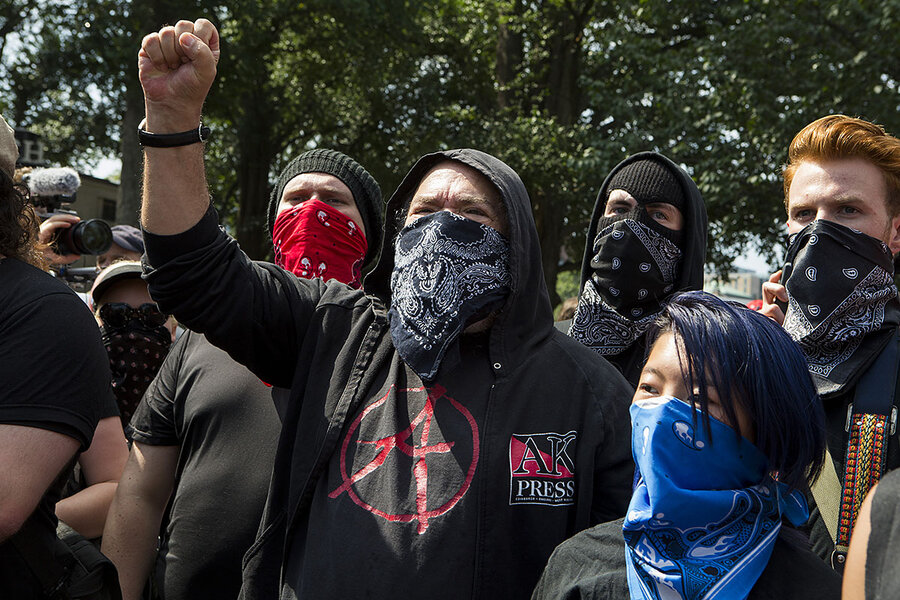What is antifa – and does its rise mean the left is becoming more violent?
Loading...
| Los Angeles
Concerns about possible violence are surfacing again in the Bay Area as the University of California, Berkeley, gears up for “Free Speech Week.” The four-day event, hosted by a conservative student group, features controversial personalities from the so-called “alt right” – a coalition of groups that espouse white nationalism, anti-Semitism, and populism.
The occasion follows counterprotests in Berkeley and other cities such as Portland that have given critics fodder to accuse leftist activists of stirring up violence in otherwise peaceful public gatherings. At the heart of the allegations is antifa, whose appearance at neo-Nazi and white nationalist rallies has led to heated, and sometimes nasty, confrontations.
Q: What is antifa?
Antifa (pronounced either AN-tifa or an-TEE-fa), is short for anti-fascist or anti-fascist action. It refers to a loose collection of far-left-leaning and anti-racist groups, networks, and individuals. The majority are anarchists, but affiliates range from far-left factions, including socialists and communists, to citizens spurred to action by the election of President Trump and upset by what they perceive as state support for white nationalism. Uniting them is a “desire to directly and even physically confront white supremacists in the public square,” says Mark Pitcavage, senior research fellow at the nonprofit Anti-Defamation League (ADL).
They also associate with opposition to homophobia, sexism, and the kind of capitalism that gave rise to the Occupy movement, among other progressive ideologies.
Q: Where do they come from?
Antifa strategies draw from the clashes between militant leftists and fascists in the streets of Germany, Italy, and Spain in the 1920s and ‘30s, writes Peter Beinart for The Atlantic. “Their conviction is that the Nazis never would’ve taken power in Germany, and similar movements wouldn’t have taken power elsewhere, if people hadn’t ceded the public square to them,” Mr. Pitcavage says.
The idea saw a resurgence in the 1970s and ’80s, when skinheads and neo-Nazis began to penetrate the punk scene in both Europe and the United States. German anti-fascists in the 1980s gave the term its modern connotation, while the Anti-Racist Action Network – a similarly deregulated association that was influenced by anarchist principles – became, in the ’80s, ’90s, and early 2000s, the core of antifa in the US, said Mark Bray, author of “Antifa: The Antifascist Handbook,” in an interview with the book’s publisher, Melville House.
“It wasn’t really until West Coast antifa shut down [alt-right commentator] Milo Yiannopoulos at UC Berkeley, however, that the term gained the mainstream attention that it has now,” he noted.
Q: How do they operate?
Antifa groups have no formal structure or national leadership. Instead they rely on local organizations like By Any Means Necessary, which originated in Detroit, and Rose City Antifa, in Portland, Ore., to engage people in direct action: anything from pressuring venues to cancel events held by white nationalist groups to tracking and exposing racists and neo-Nazis both on- and offline.
But the disruptive presence of antifa at these groups’ public gatherings has drawn the most attention – and criticism. Anarchists, who make up the bulk of antifa affiliates, tend to see the state and its structures as vehicles for oppression. To them, it’s more the streets and less Congress or the courts that serve as a crucial battleground against racist and fascist forces. That kind of thinking, analysts say, can – and sometimes does – lead to physical conflict.
Q: Does this mean the left is becoming more violent?
Not so fast. Many experts warn against conflating “the left” with antifa groups. While the antifa catalog of opposition is broad enough to resonate with progressives who don’t condone violence, even as self-defense, antifa groups make up only a small sliver of progressives and liberals, says Jody Armour, a University of Southern California professor who specializes in race, social justice, and the law.
Even if the focus were narrowed to antifa and the far left, the claim of growing violence still lacks weight, adds Pitcavage at ADL. If anything, he says, violence from the militant left is down from the 20-year period between 1965 and 1985, when groups like the Earth Liberation Front and the Symbionese Liberation Army engaged in brutal attacks and bank robberies. From 2007 to 2016, 372 people were killed by domestic extremists of all stripes, according to ADL data. Of those, only 2 percent were victims of leftist extremists, compared with 74 percent at the hands of right-wing extremists. “Zero were killed by the antifa specifically,” Pitcavage says.
None of this is meant to condone or excuse assault or other forms of violence that antifa groups employ, he and others say. And it is crucial that America remain a place where people of opposing – and even abhorrent – beliefs are able to express them without fear of violence or censorship, Professor Armour says. Which is why the idea of rationalizing violence as a necessary defense against hate can be problematic, he says. “If you start saying that, then self-defense can be used to justify anything.”
But others note it’s also important to distinguish between those who would revive Nazism or call for the return of a predominantly white America, and groups opposing them – even if the tactics the latter employ are questionable. White nationalists’ “vision of democracy is Jim Crow Alabama,” says Cathy Schneider, who teaches urban politics and comparative social movements at American University in Washington. “But I think that [antifa is] not thinking carefully enough about the long-term solution. You’re not going to win a battle in the streets.”






